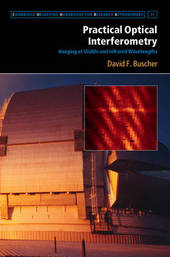
|
Practical Optical Interferometry: Imaging at Visible and Infrared Wavelengths
Hardback
Main Details
| Title |
Practical Optical Interferometry: Imaging at Visible and Infrared Wavelengths
|
| Authors and Contributors |
By (author) David F. Buscher
|
|
Foreword by Malcolm Longair
|
| Series | Cambridge Observing Handbooks for Research Astronomers |
|---|
| Physical Properties |
| Format:Hardback | | Pages:286 | | Dimensions(mm): Height 235,Width 160 |
|
| Category/Genre | Observatories, equipment and methods |
|---|
| ISBN/Barcode |
9781107042179
|
| Classifications | Dewey:522.6 |
|---|
| Audience | | Professional & Vocational | |
|---|
| Illustrations |
2 Tables, black and white; 155 Line drawings, unspecified
|
|
Publishing Details |
| Publisher |
Cambridge University Press
|
| Imprint |
Cambridge University Press
|
| Publication Date |
28 July 2015 |
| Publication Country |
United Kingdom
|
Description
Optical interferometry is a powerful technique to make images on angular scales hundreds of times smaller than is possible with the largest telescopes. This concise guide provides an introduction to the technique for graduate students and researchers who want to make interferometric observations and acts as a reference for technologists building new instruments. Starting from the principles of interference, the author covers the core concepts of interferometry, showing how the effects of the Earth's atmosphere can be overcome using closure phase, and the complete process of making an observation, from planning to image reconstruction. This rigorous approach emphasizes the use of rules-of-thumb for important parameters such as the signal-to-noise ratios, requirements for sampling the Fourier plane and predicting image quality. The handbook is supported by web resources, including the Python source code used to make many of the graphs, as well as an interferometry simulation framework, available at www.cambridge.org/9781107042179.
Author Biography
David F. Buscher is a lecturer at the Cavendish Laboratory, University of Cambridge, and is System Architect for the Magdalena Ridge Observatory Interferometer, an imaging interferometer under construction in New Mexico. He works on the design, construction and exploitation of optical interferometers and adaptive optics systems and is the UK representative on the Science Council for the European Interferometry Initiative.
Reviews'... a rare gem of clear and rigorous explanation ...' Barry R. Masters, Optics and Photonic News 'David Buscher ... is among the top tier of interferometrists internationally and has exploited his experience in creating this valuable resource for those who might want to build interferometers themselves or better utilize ones to which they have access. ... The writing style is excellent and thoughtful in anticipating questions that would arise in the minds of students who are endeavouring to understand a field that can be obscured by experts either less experienced or less caring about demistifying interferometry. Indeed, this benefits not only from Buscher's technical expertise but also from his years of teaching. Practical Optical Interferometry is a wonderful resource that fulfills a long-standing need for advanced undergraduates, graduate students, and postdocs enticed by the prospects of sub-milliarcsecond spatial resolution.' Harold A. McAlister, The Observatory 'In this slim and very readable book David F. Buscher does a fantastic job of providing a textbook, that covers the theory of using interferometry at optical and near infrared wavelengths that also provides a wealth of practical advice on all aspects of optical interferometry. It is pitched at a level valuable to undergraduate students learning about the subject, but also a useful addition for practising engineers, designers and scientists ... It is lovely to see an introduction to the topic that assumes nothing in the way of background other than basic intelligence and an interest in the topic. ... many of the ideas described are fully expressed in the interferometry simulation framework provided ... I found this to be a very helpful book and would certainly be happy to recommend it either as a good student text, or a useful read for anyone else looking for an introduction to the field.' Mark Nicol, Contemporary Physics
|